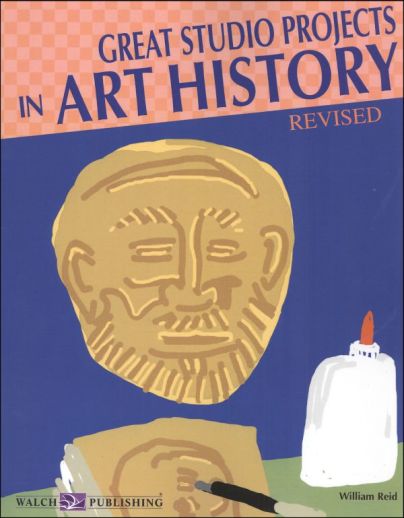We use cookies to make your experience better. To comply with the new e-Privacy directive, we need to ask for your consent to set the cookies. Learn more.
Great Studio Projects in Art History
Students experience art through history by participating in projects highlighting techniques and styles through the ages. Comprehensive in scope, the book begins with prehistoric art and progresses through the late 20th century. Each major period (Ancient World, Middle Ages, World Beyond Europe, Renaissance, Baroque and Rococo, Romantic, Impressionism & Post-Impressionism, Early 20th Century, Late 20th Century) is further divided into periods, locations, or schools of art. Each major section and sub-section begins with background information to set the stage. Within each sub-section are one or many projects designed to help students understand and appreciate concepts and methods used in art of all kinds (not limited to paintings). There are 80 different projects in all. Materials needed for the project are listed first, followed by a sample of the artwork and narrative description highlighting the type of art, method used to create it, a particular technique or feature, etc. Directions and instructions are then provided for completing a project simulating the art or concepts. To get the full visual impact of works referenced you will have to find reproductions, since the author provides only line drawings of the art. This is purposeful, since the pages are intended to be reproducible student handouts - in some cases, artwork is done directly on the page. Projects vary from simple drawings to elaborate construction. A few are extremely ambitious, but rather accurately impart the amount of effort involved in creating the type of art being studied. So much is included here that the best I can do is describe a few projects. The first project is Prehistoric Painting. Students make earth-pigment powders using brick, unglazed tile, or rock that is easily filed. A flat stone is used for a "canvas" to recreate a simple cave painting of an animal. The outline is drawn in charcoal or charcoal pencil. Earth powders are mixed with honey (just like they did way back then), and used to color within the outline. Project #20 (from Gothic Art) is creating a stained glass window using tracing paper, felt tip pens, and black construction paper. During the Italian Renaissance period (1400-1600) projects include Shading and Foreshortening, Renaissance Composition, Linear Perspective, Fresco Cartoon (mimicking the process by which frescoes where outlined before being painted), creating a picture based on one of many of Leonardo da Vinci's observations and ideas, and making a model of one of da Vinci's inventions. Project #53 has students use broad felt-tipped pens to try out Impressionist techniques on a basic line-drawn scene. I'm sure students could come up with some outlandish ideas for the Dada art project (Early 20th Century), inspired by Man Ray's Gift (an iron with tacks fixed to the bottom - a study in irony). Students will come back to earth by Project #80 (inspired by Spiral Jetty, an abstract sculpture formed with rocks and earth in Utah's Great Salt Lake) which focuses on creating art from/in nature. Students create their own earthwork, planning a simple tabletop design using stones, sand, gravel, dirt, and similar natural materials. (I have an excellent natural "collage" on my window right now - I call it The Undersides of Many Tree Frogs).
| Product Format: | Softcover Book |
|---|---|
| Brand: | Walch Education |
| Author: | William Reid |
| Grades: | 7-12 |
| ISBN: | 9780825138522 |
| EAN/UPC: | 700507014592 |
| Length in Inches: | 10.75 |
| Width in Inches: | 8.5 |
| Height in Inches: | 0.5 |
| Weight in Pounds: | 0.85 |

